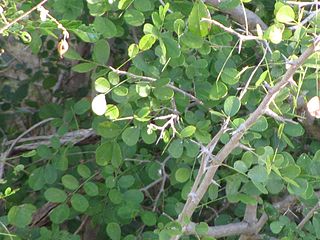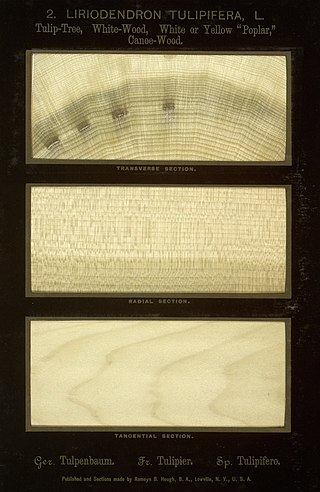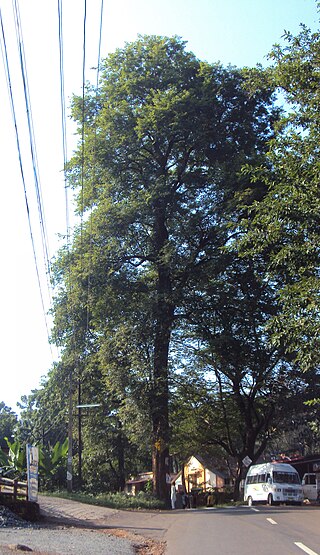
Dalbergia is a large genus of small to medium-size trees, shrubs and lianas in the pea family, Fabaceae, subfamily Faboideae. It was recently assigned to the informal monophyletic Dalbergia clade : the Dalbergieae. The genus has a wide distribution, native to the tropical regions of Central and South America, Africa, Madagascar and southern Asia.

Dalbergia melanoxylon in french Granadille d'Afrique is a flowering plant in the family Fabaceae, native to seasonally dry regions of Africa from Senegal east to Eritrea, to southern regions of Tanzania to Mozambique and south to the north-eastern parts of South Africa. The tree is an important timber species in its native areas; it is used in the manufacture of musical instruments, sculptures vinyago in Swahili language and fine furnitures. Populations and genomic resources for genetic biodiversity maintenance in parts of its native range are threatened by overharvesting due to poor or absent conservation planning and by the species' low germination rates.

The Fender Jazz Bass is the second model of electric bass created by Leo Fender. It is distinct from the Precision Bass in that its tone is brighter and richer in the midrange and treble with less emphasis on the fundamental frequency. The body shape is also different from the Precision Bass, in that the Precision Bass has a symmetrical lower bout on the body, designed after the Telecaster and Stratocaster lines of guitars, while the Jazz Bass has an offset lower bout, mimicking the design aesthetic of the Jaguar and Jazzmaster guitars.

Entandrophragma cylindricum is a tree of the genus Entandrophragma of the family Meliaceae. It is commonly known as sapele or sapelli or sapele mahogany, as well as aboudikro, assi, and muyovu.

Rosewood is any of a number of richly hued hardwoods, often brownish with darker veining, but found in other colours. It is hard, tough, strong, and dense. True rosewoods come from trees of the genus Dalbergia, but other woods are often called rosewood. Rosewood takes a high polish and is used for luxury furniture-making, flooring, musical instruments, and turnery.

Most commonly, tulipwood is the greenish yellowish wood yielded from the tulip tree, found on the Eastern side of North America and a similar species in some parts of China. In the United States, it is commonly known as tulip poplar or yellow poplar, even though the tree is not related to the poplars. It is notable for its height, which can exceed 190 feet. The wood is very light, around 490 kg per cubic meter, but very strong and is used in many applications, including furniture, joinery and moldings. It can also be stained very easily and is often used as a low-cost alternative to walnut and cherry in furniture and doors.
Tonewood refers to specific wood varieties used for woodwind or acoustic stringed instruments. The word implies that certain species exhibit qualities that enhance acoustic properties of the instruments, but other properties of the wood such as esthetics and availability have always been considered in the selection of wood for musical instruments. According to Mottola's Cyclopedic Dictionary of Lutherie Terms, tonewood is:
Wood that is used to make stringed musical instruments. The term is often used to indicate wood species that are suitable for stringed musical instruments and, by exclusion, those that are not. But the list of species generally considered to be tonewoods changes constantly and has changed constantly throughout history.

Triplochiton scleroxylon is a tree of the genus Triplochiton of the family Malvaceae. The timber is known by the common names African whitewood, abachi, obeche, wawa, ayous and sambawawa. The tree is the official state tree of Ekiti State, Nigeria.

Pterocarpus santalinus, with the common names red sanders, red saunders, Yerra Chandanam, Chenchandanam, red sandalwood, Rakta Chandana, and saunderswood, is a species of Pterocarpus endemic to the southern Eastern Ghats mountain range of South India. This tree is valued for the rich red colour of its wood, and in recent years there has been a marked uptick in the use of red sandalwood as a component of incense, especially in the west. The tree is not to be confused with the aromatic Santalum sandalwood trees that grow natively in Southern India.

Dalbergia sissoo, known commonly as North Indian rosewood or shisham, is a fast-growing, hardy, deciduous rosewood tree native to the Indian subcontinent and southern Iran. D. sissoo is a large, crooked tree with long, leathery leaves and whitish or pink flowers.

Dalbergia cochinchinensis, the Thailand rosewood, Siamese rosewood, or tracwood, is a species of legume in the family Fabaceae.

Dalbergia nigra, commonly known as the Bahia rosewood, jacarandá-da-Bahia, Brazilian rosewood, Rio rosewood, jacarandá-do-brasil, pianowood, caviúna, graúna, jacarandá-una or obuina is a species of legume in the family Fabaceae.

Dalbergia odorifera, fragrant rosewood or Chinese rosewood, is a species of true rosewood in the genus Dalbergia. It is a small or medium-sized tree, 10–15 metres (33–49 ft) tall. It is endemic to China and occurs in Fujian, Hainan, Zhejiang, and Guangdong.

Dalbergia oliveri is a species of legume in the family Fabaceae which grows in tree form to 15 – 30 meters in height. The fruit is a green pod containing one to two seeds which turn brown to black when ripe. It is threatened by habitat loss and over-harvesting for its valuable red "rosewood" timber.

Fraxinus caroliniana, the pop ash, Florida ash, swamp ash, Carolina ash, or water ash, is a species of ash tree native from Cuba through the subtropical Southeastern United States from southern Virginia to Texas. It was originally described by the botanist Philip Miller. It is a small tree about 40 ft. Leaves are compound, opposite, 7–12 in long, leaflets 5–7 in, ovate to oblong, coarsely serrate or entire, 3–6 in long, 2–3 in wide. Fruit is frequently 3-winged (samara) with flat seed portion; seed sometimes a bright violet color. It is the smallest of eastern North American ash species, wood light, soft, weak, 22 lbs./cu.ft. Typical to coastal swamps and subtropical lowlands. Like other species in the section Melioides, Fraxinus caroliniana is dioecious, with male and female flowers produced on separate individuals.

Dalbergia retusa is a plant species in the genus Dalbergia found in Pacific regions of Central America, ranging from Panama to southwestern Mexico. It produces the cocobolo wood. It is a fair-sized tree, reported to reach 20–25 m in height. This is probably the species contributing most of the wood in the trade. Because of the wood's great beauty and high value, the trees yielding this wood have been heavily exploited and are now rare outside national parks, reserves, and plantations.

Dalbergia latifolia is a premier timber species, also known as the Indian rosewood. It is native to low-elevation tropical monsoon forests of south east India. Some common names in English include rosewood, Bombay blackwood, roseta rosewood, East Indian rosewood, reddish-brown rosewood, Indian palisandre, and Java palisandre. Its Indian common names are beete, and satisal. The tree grows to 40 metres (130 ft) in height and is evergreen, but locally deciduous in drier subpopulations.
Pau ferro is a common name for several trees and may refer to:
Dalbergia stevensonii, also called Honduras rosewood, is a Central American tree species in the legume family. It grows in broadleaf evergreen swamp forests in southern Belize and adjacent Guatemala and Mexico. The wood is highly valuable, which has led to population loss from illegal logging.


















